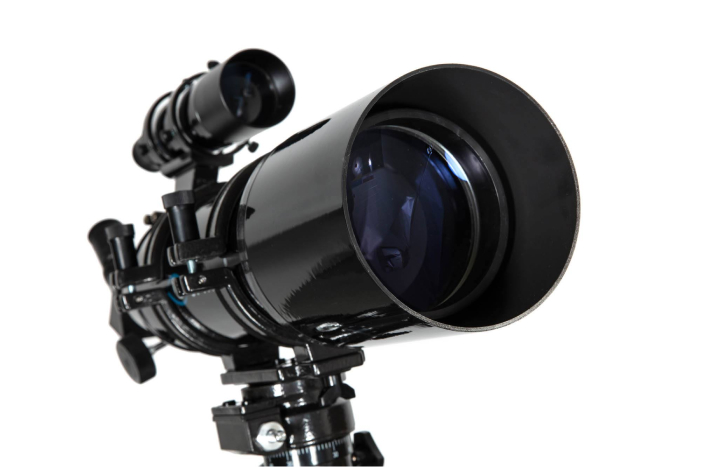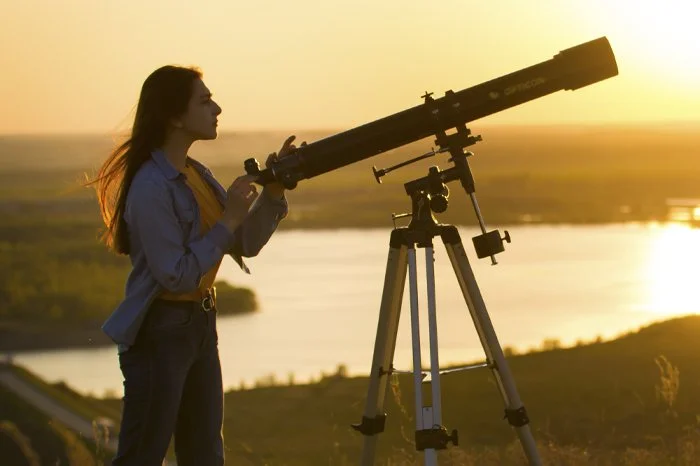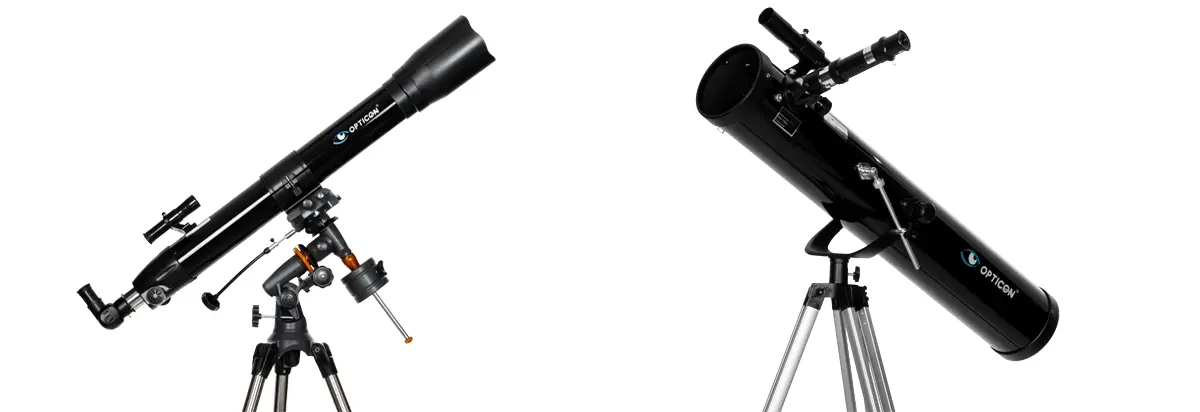Which telescope to buy? Guide for amateurs
The sky can be really fascinating, and anyone who is willing to poke his or her head up is finding that out. Observing the sun, stars, planets, nebulae and many other elements of our solar system are attracting more and more people. They can be a great hobby for everyone, both adults and children. However, it is known to anyone, even a novice astronomy enthusiast, that admiring the sky is not possible without the right equipment. Astronomical objects are millions of kilometers away from us, and in order to see them well you need an astronomical telescope. It is available in different types, and each model can have different parameters. So which telescope should you choose? We will try to answer this question.
Types of telescopes and how they work
Telescopes are the optical devices that are used to magnify various types of objects. Their general working principles are as follows: a telescope catches electromagnetic waves of light and then focuses them by refraction or reflection. This makes a given object brighter and magnified, so it can be seen with the naked eye. There are two main types of telescopes: refracting and reflecting telescopes, which differ in construction and operating principles. Both give a real and magnified image, but it can be straight or inverted.
Refracting telescopes
Refracting telescopes, or refractors, were the first tools for making astronomical observations. They were developed in the 17th century, but are still used today. Their modern forms are successfully used by both beginners and scientists.
A refractor is built with an objective consisting of lenses and an eyepiece. The lenses refract light and change its direction, transmitting its beams to the eyepiece. This results in a magnified image, which, depending on the design, can be straight or inverted. However, equipment of this type of construction is not free of defects. We are accompanied by chromatic aberrations that interfere with image quality. This problem was tried to eliminate as early as the 17th century, which is why Newtonian reflector telescopes were developed.
Newtonian reflector telescope
The reflector, as the reflecting telescope is also called, was the first to be constructed by Newton. Various scientists created designs for new telescopes, but it was Newton who first engineered the actual working equipment. Instead of lenses, he used a prism and a mirror, which reflects light rays and focuses them in one place.
The design of the mirror is a little more complicated, it uses an additional smaller secondary mirror and gives an inverted image. It, as well, has defects in the form of spherical aberration, which is why it has undergone numerous modifications to correct them. Some of the new designs are gone, while others are still used by the scientific community. For beginning astronomy enthusiasts, Newtonian telescopes are still the best available.
Reflector or refractor telescope - which for observing solar system objects?
You have learned the differences between refractors and reflectors, but do you already know which telescope to choose? Do not worry if not, because there is no definite answer to this question. The topic of astronomical telescopes is complex and quite complicated.
First of all, the capabilities of a given telescope depend on its optical elements. Related to them are such parameters as magnification, contrast and image quality in general, which affect any observation. A lot also depends on the conditions under which the observation is carried out. Therefore, it cannot be said that one type of telescope is better than another. If that were the case, we would only have one type of telescope to choose from. However, we can tell you which telescope will work better for observing specific objects in the sky.
The refractor obtains an image with better contrast, so it works better for observing brighter objects. It allows you to observe planets, the Moon or double stars. Its construction is simpler, it does not need to be set up and it is easier to take care of its maintenance.
The reflector is better suited for observing darker objects in the sky: clusters, nebulae and galaxies. It requires optimal adjustment of optical elements, which can be complicated for beginners. Before buying a telescope, you must also decide whether you also plan to conduct observations of terrestrial objects. If so, then here a refractor will work better due to the fact that it gives an un-reversed image.
The most important elements and parameters of telescopes
Every night sky observer knows how important a good quality telescope is, especially its optical components. The capabilities of the telescope - magnification, image quality and detail - depend on them. Better equipment will allow you to see more, and this is very important also for beginners. If you are not satisfied with your observations, then you will probably quickly abandon your hobby. So you need to take into account the parameters of the optics of a particular design, so as not to disappoint your own expectations.
1. Diameter of lens or mirror
In observing the sky, the diameter of the lens or mirror is very important. The diameter of the lens/mirror determines how much light the telescope will capture. A larger diameter means more rays and thus better brightness of the observed objects.
2. Telescope magnification
The magnification also determines the capabilities of the equipment and the quality of the observations made. It is what gives us the impression that the stars or planets will be closer to us. To calculate the maximum magnification of a telescope, divide the focal length of the telescope by the focal length of the eyepiece. You will then find out how many times the object will be magnified. Since the magnification parameter is also affected by the eyepiece, which is an interchangeable element, you can change the magnification in the telescope according to your needs. Remember that the magnification cannot be higher than the aperture in the telescope. We calculate it by doubling the diameter of the lens or mirror.

The diameter of the lens is one of the most important elements of a telescope
How many times a telescope can magnify an object is important, but it is not the most important parameter. Too much magnification can even be unfavorable, as the image can then lose quality. You should pay much more attention to the quality of the mirror and lens, their diameter, as well as the eyepiece. It also plays an important role in the telescope.
3. Field of view of the eyepiece
Every telescope has an eyepiece and this is the element through which we look at the sky. The most important thing about an eyepiece is the field of view, which should be as large as possible. The best eyepieces have a field of view of as much as 90 degrees, but they cost several hundred or several thousand pounds and are used mainly by professionals. For a beginner star lover, eyepieces with a field of view of 40-55 degrees will be sufficient, but a lot also depends on their quality. The choice of eyepieces with an optimal field of view is very important, because of the greater range of the area that we can observe with the given equipment.
What to look for when buying a telescope?
The choice of the right telescope depends on our expectations, the conditions in which we will conduct observations and what objects we want to see. It is worth considering these particular issues before buying.
1. Types of objects in the sky
To begin with, you must answer the question, what objects in the sky do you want to observe? Larger astronomical objects like planets, stars and the Moon are brighter, so you don't need professional equipment to make observations. It's best to opt for a good refractor with a minimum diameter of 50 mm or a mirror with a diameter of 100 mm. With the help of such a telescope, you can conduct successful observations already. Such equipment is able to present you with an image of Saturn, the Moon or even brighter galaxies capturing the light emitted or reflected by many stars and planets.
2. The observer
The observer himself is also an important element. Others telescopes will be suitable for a beginner adult, others for a child, and still others for advanced astronomy enthusiasts. It is necessary to match the astronomical equipment to the expectations and knowledge of its user. A telescope model for children should certainly be lighter and easier to use than a telescope designed for a teenager or adult.
3. Place of the observation
The place of observation of objects in the sky is also important. Different conditions are in the city, where numerous lights pollute the sky, others in rural areas, where light is less of an obstacle, and still others in the mountains, which are far from light sources. There is a lot of light in cities and suburban areas, so only the brightest objects can be observed from such places. You will see the moon and planets in the city already with a refractor with a diameter of 100 mm. In such conditions, it allows you to see even more than a 150 mm diameter reflector. For observing the Moon, even ordinary binoculars with a diameter of 50 mm are often enough, but remember that they will not show you much detail.

What telescope to choose for beginner astronomy enthusiasts?
If you are wondering what telescope to choose, you are probably one the beginners in astronomy for now. The topic of buying your first telescope is certainly the most difficult, since you do not yet know what to expect from the equipment. Certainly, among the various telescope models, you should choose one that will serve you for a long time. This depends not only on the quality of the individual telescope parts, but also on its parameters.
Compare the dimensions of the telescopes
Compare the dimensions of the telescopes
A telescope with weaker capabilities will quickly become insufficient for you, so it is better to invest in equipment with a larger lens or mirror diameter. It should be 80-110 mm for the lens or 100-150 mm for the mirror. Such a diameter already allows you to have a lot of observation possibilities. Before buying, consider what kind of stars you want to admire. First, choose models with a simple, good quality design. Do not make your choice dependent on magnification, but pay attention to much more important optical parameters.
What else do you need to know to choose a telescope?
You already know the types and parameters of telescopes, as well as what kind of observations they are suitable for. However, these are not all the issues that will allow you to choose a telescope. You also need to consider your budget, the mobility of the telescope, and the usefulness of additional equipment.
We do not hide the fact that the hobby of astronomy can be expensive. The best models of telescopes are very expensive, the price also depends on the brand, but you do not at all have to invest in high-end telescopes right away. For beginner astronomy enthusiasts, telescopes in the 100-150 pounds range will already be satisfactory. If your budget is smaller, you can choose equipment with basic parameters to begin with, and then upgrade it with better eyepieces, lenses and additional accessories.
Size of the construction
Telescopes can have very different dimensions, which depend on the diameter of the lens or mirror. Larger diameter means better views, but also increased size and weight of telescopes. Large telescopes have better performance, but there is a problem with carrying them. And to admire the stars, we need to move with the telescope. A compromise is necessary. You should opt for a telescope that has good quality and at the same time is easy to carry.
Additional accessories
The convenience of using telescopes is also affected by additional accessories. With them you can also improve the parameters of the equipment. Increase the field of view or get better magnifications of objects. You should certainly opt for a set of 2-3 eyepieces, a Barlow lens and a stable tripod. Barlow lenses affect the magnification parameter, and a stable and sturdy tripod certainly makes it easier to view the sky.
Do you already know which telescope to choose?
There are various models of telescopes on the market, so choosing the right one is not easy at all. We hope that our guide will allow you to choose the telescope that best suits your expectations. Certainly, making a decision requires learning a lot of terms, as well as asking questions, which we encourage you to do. We will be happy to resolve your doubts and help you make a choice.
Did you like our post? Looking for additional information about telescopes and microscopes?
Check out similar entries:



